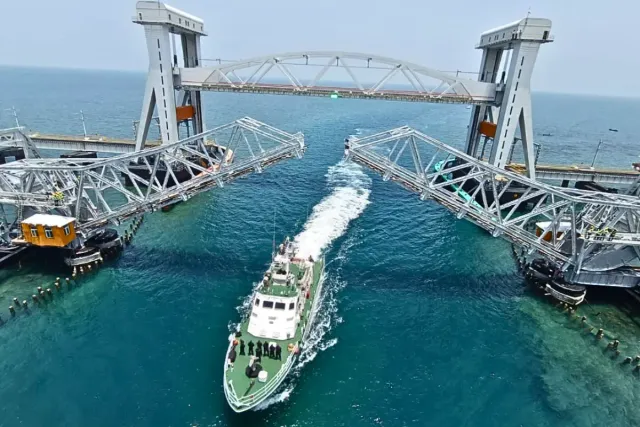Pamban Bridge: India’s engineering landscape witnessed a monumental moment when PM Modi inaugurated the New Pamban Railway Bridge in Rameswaram, Tamil Nadu. This marvel is not just another railway bridge—it’s a blend of heritage and hi-tech, connecting the spiritual island town to the mainland like never before.
Let’s explore how this coastal masterpiece was built, how much it cost, and what materials made it stand strong against the sea.
What Makes the New Pamban Railway Bridge So Special?
The New Pamban Railway Bridge is India’s first vertical lift sea bridge, marking a major leap in modern rail infrastructure. PM Modi inaugurated the bridge and even operated its lift span to allow a Coast Guard ship to pass beneath—showcasing a remarkable feat of precision engineering.
India’s Engineering Marvel is Here!
The New Pamban Rail Bridge is India’s first vertical lift sea bridge!
🌉 Rises 17m high in just 5 minutes for seamless maritime navigation
🚆 Strengthens connectivity between Rameswaram and mainland India
✨ Enables faster, smoother rail… pic.twitter.com/wU2IeSMlb5— MyGovIndia (@mygovindia) April 5, 2025
This advanced bridge replaces the old Pamban Bridge, which had served India since 1914. While the original used a manually operated rolling lift system, the new version is fully automated and built with a vision for the next 100 years.
How Was the Pamban Bridge Constructed?
Wondering how the Pamban Bridge was constructed? The project was executed by Rail Vikas Nigam Limited (RVNL), a public sector unit under the Ministry of Railways. Engineers employed cutting-edge techniques like Phased Array Ultrasonic Testing (PAUT) for welding checks, ensuring each joint was solid and secure.
The girder segments were painted and inspected at a separate site, transported by trucks, and assembled on a temporary platform using EOT cranes. This helped in maintaining accuracy and reducing on-site complications.
What Was the Cost of the Pamban Bridge?
The total Pamban Bridge cost was around Rs 550 crore. Given its scale and features, this cost is considered economical for a structure of such complexity.
The 2.08-kilometre-long bridge consists of 99 spans and a central 72.5-metre vertical lift span that rises up to 17 metres—enough for large ships to pass without halting train movement.
Which Materials Were Used in the Pamban Bridge?
The materials used in the Pamban Bridge were chosen to withstand harsh marine conditions. Key components include:
- Stainless steel reinforcement for corrosion resistance
- Fully welded joints for long-lasting durability
- Polysiloxane coating and high-grade protective paints for extra protection against sea air
This ensures minimal maintenance and a 100-year projected lifespan.
Why Is the New Pamban Railway Bridge Important for Rameswaram?
Beyond engineering brilliance, the New Pamban Railway Bridge holds deep cultural and regional significance. It strengthens connectivity to Rameswaram, a major pilgrimage centre in Tamil Nadu. PM Modi also flagged off a train from Rameswaram to Tambaram, boosting regional links and tourism.
Indian Railways called it a symbol of “bridging the past, lifting the new.” And rightly so—it’s a shining example of how India is blending tradition with innovation.




